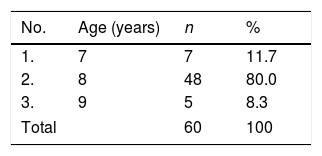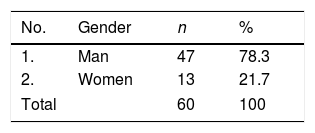In the last year ADHD (Attention Deficit Hyperactivity Disorders) has become a problem that is in the spotlight and is a major concern in the medical community or in the general public. The number of people with ADHD (Attention Deficit Hyperactivity Disorders) appears to be increasing rapidly in the past decade. People with ADHD (Attention Deficit Hyperactivity Disorders) who have the opportunity to be diagnosed earlier allow earlier management with better results. Early detection is very important and affects the prognosis of the patient. Therefore, an optimal early detection effort is needed.
This study aims to determine Attention Deficit Hyperactive Disorder in children aged 7–10 years through early detection at Poasia 1 Elementary School Kendari.
This study uses observational analytic research. The population in this study were all children aged 7–10 years who were in Poasia 1 State Elementary School Kendari taken randomly. Data collection is done using a questionnaire and conducting in-depth interviews with children.
The results were found to have symptoms of the domain of ADHD (Attention Deficit Hyperactivity Disorders) with an inattention of 10%, which had a hyperactivity of 54%, while those based on male sex 4.3% and those of female sex 21.7%.
It is expected that parents can monitor children's development so that they can know the child's development at any time.
Problems with hyperactivity as part of ADHD (Attention Deficit Hyperactive Disorder), which is the most common neurological behavior disorder that occurs in childhood, and is a form of behavioral disorder with the highest number of chronic affective disorder occurrences in school-age children, usually also accompanied by a variety of other functional obstacles, such as low academic ability in school, interpersonal relations problems both with family or with the surrounding environment (playmates) and tend to lack confidence (inferior). This can continue into adolescence even as adults. This concentration of attention or hyperactivity disorder is usually characterized by the attitude of the child cannot sit quietly, always moving, hands and feet cannot silently run and jump more than usual, and easily agitated.1
Now many parents who unconsciously assess the behavior of hyperactive children are normal. If this disorder is left without immediate treatment, it can cause the child to experience learning difficulties. Handling must be taken seriously. With early detection and special handling, it is expected that children with hyperactive disorders can successfully pass through school and reach a bright future.2
Hyperactive disorder is one disorder that is often found in behavioral disorders in children. In the past, hyperactive disorders have become a problem that is in the spotlight and is a major concern among the medical community and the general public.3 School-age children range from 3 to 5%. Developmental disorders that have a symptom onset of age 7 years. After the age of the child will settle for adolescence or adulthood, it is estimated that people with ADHD (Attention Deficit Hyperactive Disorder) will settle around 15–20% as adults. About 65% will experience sequelae at adulthood. Early detection of ADHD (Attention Deficit Hyperactive Disorder) is very important to be done to minimize the symptoms and consequences caused later on this involve several layers of society both medical and non-medical.4
The purpose of this study was: Identifying Attention Deficit Hyperactivity Disorder for children aged 7–10 years at Poasia 1 Elementary School Kendari and Identify the most dominant symptoms related to the case of Attention Deficit Hyperactivity Disorder at Poasia 1 Elementary School Kendari and Identify the number of sex ratios/sexes of children aged 7–10 years who experience Attention Deficit Hyperactivity Disorder at Poasia 1 Public Elementary School Kendari.
MethodsIn this study using observational analytic. Population and study setting: In this study using observational analytic, with the sampling technique using Simple random sampling.5 The variable in this study was Attention Deficit Hyperactivity Disorder, the most dominant symptom related to cases of Attention Deficit Hyperactivity Disorder and how big the sex ratio/sex of children aged 7–10 years. The data used in this study are primary data. Data analysis uses those consisting of univariate.
Results- -
Distribution based on age in Poasia 1 Elementary School Kendari City (Table 1)
Discussing the age of 8 years showed more symptoms of Attention Hyperactivity, namely 48 respondents (80.0%) while the age of 9 years showed symptoms of Attention Hyperactivity, namely 5 respondents (8.3%).
- -
Sample distribution based on dominant symptoms in Poasia 1 Elementary School in Kendari City (Table 2)
The most dominant symptom in the Attention Hyperactivity symptom in this case is Inattention, which is 54 respondents (90.0%) while the one showing the symptoms of Attention Hyperactivity in this case Hyperactivity–Impulsivity is 6 respondents (10.0%).
- -
Sample distribution based on gender in Poasia 1 Elementary School Kendari City (Table 3)
Male sex 47 respondents (78.3%) at the most had symptoms of Attention Hyperactivity while in female sex who had symptoms of Attention Hyperactivity, 13 respondents (21.7%) (Tables 1–3).
Based on the most dominant age, the symptoms of hyperactivity in SD Negeri 1 Poasia were seen at the age of 8 years due to the high correlation of hyperactivity that occurred in families with hyperactive children. Approximately 25–35% of parents and siblings whose childhood is hyperactive will decrease in children and it was known that in SD Negeri 1 Poasia for selling snacks for children of various kinds and this was one of the trigger factors. It was also seen in twins. Apart from genetic factors also obtained from unhealthy environmental factors exposure to paint, tima mixed in the air that can be inhaled causes hyperactivity, besides that for the age of 8 years where in the eighth year the outer left brain developed rapidly. Mathematics lessons can be stuffed with them. His attention to the surrounding area has begun to expand. They have shown the desire to rule and control the situation.
In the prenatal period, CNS dysfunction is caused by metabolic, genetic, infectious, intoxication, and psychogenic factors. In the perinatal period, it is caused by prematurity, postdate, obstacle in labor, induction of labor, location abnormalities (baby presentation), therapeutic side effects, immune system depression and trauma at normal birth. Childhood (toddlers) due to infection, trauma, medical therapy, poisoning, metabolic disorders, vascular disorders, psychiatric factors, malignancy and the occurrence of seizures.6
Based on the result, students Attention Deficit Hyperactivity Disorder shows six or more symptoms unable to focus attention. Where this lasts at least six months at the maladaptive degree and is not in accordance with the level of development. The most dominant symptom is Hyperactivity–Impulsivity of 54 respondents. Where children at SD Negeri 1 Poasia present symptoms of Hyperactivity–Impulsivity among others. Students are often nervous, hands and feet cannot be quiet and cannot sit still, often leaving seating in class, often running around and talking excessively. This is because there is an increase in the intensity of symptoms in children with a higher class level, indicating that at the time the child is required to have the ability to focus better when compared to the lower grade level. The need for learning and academic achievement is one of the guidelines when at a higher class level.
Generally, Attention Deficit Hyperactivity Disorder appears at the beginning of a child's life or when he reaches school age, it is known that as many as 4% of adults in Indonesia experience Attention Deficit Hyperactivity Disorder. Case of Attention Deficit Hyperactivity Disorder is more common in boys than girls, there are some things that are thought to be a causative factor, such as genetics, brain anatomical structure, or brain neurochemical factors that are disrupted when pregnant women experience stress and depression and exposure to cigarettes and alcohol.7
The male sex of 47 respondents who had the most symptoms of Attention Hyperactivity was due to the fact that in boys the regional cerebral metabolism for glucose decreases resulting in an increase in activity where one of the activities is excessive anxiety compared to girls. Boys also have ignorance of their words indifferent to what they do without thinking about what risks they get. Whereas in the female sex who had symptoms of Attention Hyperactivity were 13 respondents.
This is because the cerebral blood flow experience an increase in metabolism to glucose which has an influence on the activities carried out by each female child who still behaves as naturally as not excessive like men even though hyperactivity in women is inherent.8
Based on the results of the study through the Andalas Health journal, it was found that boys have a higher incidence rate than girls, namely 2:1. This can be caused by things, one of which is genetic mechanisms related to sex. Boys show more cognitive weakness. The research conducted by Hill9 shows hyperactive children producing theta waves is a brain wave in the range of 4–8Hz frequency. Yan is produced by the subconscious mind.
Conflict of interestThe authors declare no conflict of interest.
Peer-review under responsibility of the scientific committee of the 3rd International Conference on Healthcare and Allied Sciences (2019). Full-text and the content of it is under responsibility of authors of the article.









